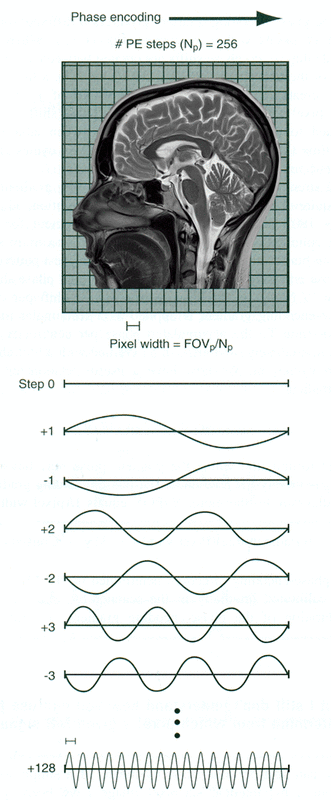Note to reader: Please make sure you understand the 2-pixel phase-encoding example in the last Q&A before proceeding on to this more complicated example.
We expand our previous 2-pixel Q&A example to a 6-pixel one, showing how Fourier transformation is used to sort out overlapping signal contributions in two dimensions. Below is a 2x3 array of pixels (A-F) at the center of a brain image with frequency- and phase-encoding directions as designated.
In this simple experiment we again play out only two phase-encoding steps. In Step 0 the PE gradient is off and the signals from all pixels remain in phase. In Step 2 we assume the pixels in the second row (B, D, and F) all acquire a phase shift of 180° relative to row 1. After each phase-encoding step, a single aggregate MR signal is recorded reflecting contributions from each of the six pixels. Hence in this simple example with only two phase-encoding steps, exactly 2 MR signals are recorded from the slice.
Advanced Discussion (show/hide)»
No supplementary material yet. Check back soon!
References
Felmlee JP, Morin RL, Salutz JR, Lund GB. Magnetic resonance imaging phase encoding: a pictorial essay. Radiographics 1989; 9:717-722.
Wald L. MR image encoding. (From MIT OpenCourseWare http://ocw.mit.edu)
Felmlee JP, Morin RL, Salutz JR, Lund GB. Magnetic resonance imaging phase encoding: a pictorial essay. Radiographics 1989; 9:717-722.
Wald L. MR image encoding. (From MIT OpenCourseWare http://ocw.mit.edu)
Related Questions
I understand frequency-encoding, but I just don't get phase-encoding. Can you explain?
What is a Fourier transform?
I think I see how to calculate pixel values in your simple examples, but how do you do this in a real image with thousands of pixels?
I understand frequency-encoding, but I just don't get phase-encoding. Can you explain?
What is a Fourier transform?
I think I see how to calculate pixel values in your simple examples, but how do you do this in a real image with thousands of pixels?



